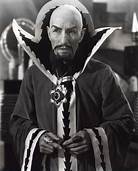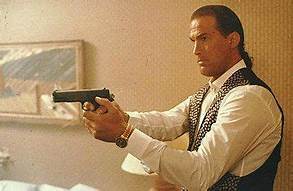Steven Pressfield's Blog, page 20
April 6, 2022
Resistance Thrives in Darkness
Resistance kicked my butt for almost a decade in my twenties. I’ve written about this in The War of Art. I crossed the country thirteen times in that era, driving my ’65 Chevy van, for no reason whatsoever except that I was running away from myself and my obligation to do my own work and follow my own calling.
But here’s the key point:
The reason Resistance won was that I had no idea it existed.
 We all have our private images of Resistance. This is mine. “Ming the Merciless” from the old FLASH GORDON serials.
We all have our private images of Resistance. This is mine. “Ming the Merciless” from the old FLASH GORDON serials.Resistance thrives in darkness.
Resistance loves secrecy.
Resistance’s most diabolical trick is that it masquerades so convincingly as our own voice.
When we hear ourselves thinking,
“You’re a bum, you’re a loser, you’ve got no talent … “
Or
“Who do you think you are, dreaming of making a movie, starting a business, writing a book? You? Don’t make me laugh!”
We think that voice is us. We believe that these thoughts are ours, that they are an objective self-assessment offered up by our own selves. They’re not.
They’re Resistance.
If you don’t believe me, let me show you the thousands of e-mails and letters I’ve gotten in which totally disparate, unknown-to-one-another individuals report the chatter they hear in their heads.
The voice is identical in every case.
Everyone hears the exact same thing.
The genius of Resistance (and why it’s so powerful) is it convinces each of us that that’s our voice.
If it’s our voice, we’ve gotta believe it, right?
If I could implant one solitary thought in the brains of every struggling soul on the planet, it would be this:
That negative, self-sabotaging voice you hear in your head is not you.
Those thoughts are not yours.
They are Resistance.
Everyone hears that same voice.
Ignore it.
Resistance thrives in darkness.
Bring Resistance into the light and you defeat it.
The post Resistance Thrives in Darkness first appeared on Steven Pressfield.March 30, 2022
Eugen Herrigel picks up his bow
Eugen Herrigel (1884-1955) was a young German philosopher who took up the study of archery in Japan as a means of deepening his understanding of Zen Buddhism and of the concept of “no-mind.” He studied under the master Awa Kenzo and wrote about it in his classic, Zen and the Art of Archery.
The challenge for Herrigel came down to the moment of releasing the arrow. He would hang on too long or let go too soon. He would force it. He would apply his ego. He would attempt to control the motion. He couldn’t get it right.
The arrow, according to his master and to true Zen, must “release itself.”
 The hardest thing in the world, said Herrigel, is to let go.
The hardest thing in the world, said Herrigel, is to let go.How does the artist learn to access the higher dimension? Not through will or ego, except as will or ego exhausts itself over time and finally “gives up.” Like Herrigel learning to let the arrow release itself, the artist builds up all her work and effort and intentionality and then lets them all go. She surrenders.
Can you do this?
I couldn’t. Not for years and years.
The post Eugen Herrigel picks up his bow first appeared on Steven Pressfield.March 23, 2022
The Artist’s Work
The artist’s work, like the migrant laborer’s, requires intention. It requires will. The artist must want to achieve her end.
The artist’s work requires effort. It demands exertion. The artist, like the teamster or the arc-welder, must summon her resources, mental as well as physical, and apply them in the direction of the task she wishes to accomplish.
 The artist’s work is for others, not for herself.
The artist’s work is for others, not for herself.The artist’s labor, like the coal miner’s, is enacted in the teeth of active resistance. As the seam of anthracite fights against being broken apart and extracted, so the choreographer’s vision of movement resists her conceiving it, grasping it, enacting it.
The artist’s toil, like the stevedore’s, requires patience and perseverance. It demands effort over time. The artist must return day after day, week after week, to her task.
The artist’s work involves risk. Failure. Exposure. A dream crushed.
The artist’s labor requires courage. It demands grit and guts. The artist digs like a miner. The artist erects like a stonemason. The artist hunts, the artist fishes, the artist plants and plows, the artist tends, the artist harvests.
Everything the artist does has its parallel in physical labor.
The only difference is the artist’s workplace is her imagination. Her toil is mental. Her field and factory reside in her head.
The post The Artist’s Work first appeared on Steven Pressfield.March 16, 2022
Living in Your Head
What exactly is the artist’s work?
There’s a great image—silent, part of a montage—in the 1977 movie Julia. Jane Fonda plays the playwright Lillian Hellman. The shot is of Fonda, bundled up against the elements, walking alone along a wind-buffeted beach. The season seems like autumn, the setting is some writerly province like Swampscott or Martha’s Vineyard. Fonda as Lillian Hellman strides, deep in thought. We see her from a bit of a distance, from behind and to the side, so we can’t see her face or hear anything above the sound of the wind and the waves, but we see her hands move, expressively, as if she were in conversation with someone.
She is.
She’s talking to her characters. She is her characters.
 Jane Fonda as Lillain Hellman in “Julia”
Jane Fonda as Lillain Hellman in “Julia”Fonda/Hellman is not on the beach; she’s in a scene in her play. The dialogue and action are playing—or trying to play—in her head.
This is work.
This is the artist’s work.
The post Living in Your Head first appeared on Steven Pressfield.March 9, 2022
No Such Thing as Writer’s Block
Whatever talent I might possess as a writer can flee tomorrow. I don’t care.

Nothing can stop me from working.
The post No Such Thing as Writer’s Block first appeared on Steven Pressfield.March 2, 2022
The Universe is Self-ordering
Imagine yourself back at the beginning of time. The universe is raw energy, blasting faster than the speed of light in all directions.
What happens? As time passes—maybe only nanoseconds—electrons coalesce around nuclei. Molten matter cools; stars and planets form themselves into spheres; celestial objects find paths and settle into orbits. Order emerges.
 The Horsehead Nebula in the constellation Orion
The Horsehead Nebula in the constellation OrionGravity exerts itself. On planets with hydrogen and oxygen, water appears. Rivers form and run downhill. Seas arise. Atmospheres stabilize. Before we know it, we’re seeing adventurous fish crawling up onto dry land, hominids beating each other’s brains out with sticks and clubs, and geeks with pocket protectors doing IPOs for social networking startups.
What about your novel?
Books wanna be what they wanna be. So do albums, entrepreneurial ventures, and statues of David. The process unfolds infallibly. Our symphony-in-the-works evolves into four movements, our screenplay organizes itself into three acts.
If we just keep plugging away at our vision, the Law of Self-Ordering comes to our aid. Work—day-in, day-out exertion and passion and concentration—produces progress and order. That’s a law of the universe.
Keep working.
The post The Universe is Self-ordering first appeared on Steven Pressfield.February 23, 2022
Becoming Picasso
When we think of Picasso we imagine Cubist tours de force like Guernica and Les Demoiselles d’Avignon, where horses have their heads turned around backward and young women pose with two eyes on one side of their faces. But the young Pablo used to plant himself in the Louvre before pure representational masterpieces by Rembrandt and Leonardo and copy them stroke for stroke.
 Picasso didn’t always paint like Picasso
Picasso didn’t always paint like PicassoAspiring film directors from Columbia and NYU take their iPhones and Galaxies to the Metropolitan Museum of Art and recreate shot-for-shot the stalking sequence from Brian De Palma’s Dressed to Kill.
Kobe Bryant’s fade-away jumper? He studied film of Michael Jordan till he could plant his Nikes in the identical spots on the floor and elevate with the exact same lift and rotation.
This is work too.
This is mastering your craft.
I used to sit for days at my ancient Smith-Corona copying pages and chapters and entire books from Hemingway and Henry Miller. To this day I can quote entire passages from The Sun Also Rises and Tropic of Capricorn.
It’s not aping or slavish emulation to immerse ourselves in the works of the masters to the point of copying them line-for-line. The masters did it themselves, studying earlier masters.
This how we learn.
This is how we evolve our own style and our own voice.
The young Eric Clapton studied B.B. King’s guitar work lick-for-lick, just as Bob Dylan emulated Woody Guthrie’s singing style and Linda Ronstadt listened note-for-note to Betty Everett and Buddy Holly. How many hip-hop artists have followed beat-for-beat behind Dr. Dre or Grandmaster Flash?
The post Becoming Picasso first appeared on Steven Pressfield.February 16, 2022
Study the Canon
Have you read War and Peace? The Brothers Karamazov? Anna Karenina?
Have you watched Double Indemnity? Casablanca? The Grapes of Wrath?
This is work.
This counts as work.
It’s also fun.
I was lucky enough in my late twenties to have two years straight when I did nothing but write and read. I read Homer, Herodotus, Thucydides, Xenophon, Plato, Aeschylus, Sophocles, Euripides, Aristophanes. I read Caesar, Livy, Cicero, Seneca, Epictetus, Marcus Aurelius; I read Flaubert and Victor Hugo, Montaigne and La Rochefoucauld. I read Sartre and Simone de Beauvoir, Knut Hamsun, Andre Malraux, Giuseppe Lampedusa, Jean Rhys, Italo Calvino. I imbibed the full modern canon—Tolstoy, Dostoevsky, Chekhov, Turgenev. Stendhal, Hawthorne, Melville, Hemingway, Fitzgerald. Japanese, writers, Chinese writers. Was I crazy?
I was learning my craft.
There are books and movies and plays and songs that you simply have to know if you call yourself a writer or artist or aspire to one day become one.
 Rosanne Cash and her Dad
Rosanne Cash and her DadHave you listened to Rosanne Cash’s album, The List? Here she is, from an interview with Terry Gross on NPR:
“When I was 18 years old, I went on the road with my dad after I graduated from high school. And we were riding on the tour bus one day, kind of rolling through the South. We started talking about songs, and he mentioned one, and I said I don’t know that one. And he mentioned another. I said, ‘I don’t know that one either, Dad,’ and he became very alarmed that I didn’t know what he considered my own musical genealogy. So he spent the rest of the afternoon making a list for me, and at the end of the day, he said, ‘This is your education.’ And across the top of the page, he wrote ‘100 Essential Country Songs.'”
Despite his heading of the list, Johnny Cash didn’t limit his definition to what might be called “country” music.
“The list might have been better titled ‘100 Essential American Songs,’ because it was very comprehensive. He covered every critical point in Southern and American music: early folk songs, protest songs, Delta blues, Southern gospel, early country music, Appalachian. Everything that fed into modern country music was on that list.”
My own (Hollywood) version of Rosanne’s come-to-Jesus moment happened—more than once—in story meetings at movie studios. Someone would make a reference to a line from Out of the Past or an action sequence from Red Sorghum. Of course I had never heard of them. All I could do was my best Homer Simpson impression and hope the conversation moved on quickly.
You have to know the canon.
The post Study the Canon first appeared on Steven Pressfield.February 9, 2022
“Think of this movie as a sausage … “
I was in a production meeting at Warner Bros. for the second Steven Seagal movie, Hard to Kill. It was called Seven Year Storm at that time. The director was Bruce Malmuth, a good guy who sadly died way too soon.
 Steven Seagal in Hard to Kill
Steven Seagal in Hard to KillThe screenplay had a car chase in it. The movie was low-budget and the sequence was scripted very tightly. Bruce however, lying awake the night before this meeting, had come up with a way to make the chase different and special. But he needed more money from the studio and an extra day of shooting. I remember Bruce rising from his chair and making an impassioned plea for just a few more bucks and a little extra time.
The Warners executive listened calmly with no change of expression. Bruce resumed his seat. He was actually out of breath from making his fervent plea. The exec thanked Bruce for his commitment and his creativity. He saluted him as a dedicated filmmaker and a true artist. Then he said:
“Bruce, think of this movie as a sausage. It’s just another link and you’re grinding it out.”
Everyone around the table, including Bruce, burst into laughter. But we all felt a chill too, at hearing stated in such stark, unvarnished terms the reality of the marketplace.
I remember thinking at the time,
I agree with the executive. This movie IS a sausage. And we ARE grinding it out.
But my attitude toward the grinding, I said to myself, does not have to be cynical or condescending. In fact,
I am grateful as hell to be here working on this sausage and to have a chance to grind it out.
And furthermore …
Nobody, including the studio and the studio executive, can stop me from giving my all to make it the best possible sausage.
In the end I got fired off the picture. You won’t find my name in the credits. But I still agree with what I thought then.
The post “Think of this movie as a sausage … “ first appeared on Steven Pressfield.Every project doesn’t have to be Citizen Kane. It’s okay to work on “B” movies and “C” movies or to write trade ads for Preparation H. As long as we do our absolute best and keep our eyes on the prize of producing, in the end, our own best material, as truly as we can to our own lights.
February 2, 2022
Liz Gilbert’s Deal with Herself
Elizabeth Gilbert is the author of Eat Pray Love and other bestsellers. She’s also a deep and honorable thinker on the subject of the artist and the artist’s soul. When Ms. Gilbert was starting out, she famously declared, she made a deal with her writing.
I will never ask you to support me. I will support you.
 Elizabeth Gilbert
Elizabeth Gilbert Let me set that before us again.
I will never ask you to support me. I will support you.
What Ms. Gilbert was declaring for herself and to herself was that if she had to toil as a barista, if she had to drive for Uber, if she had to take a job at Hooters, she would do it.
She would not compromise her writing. She would not sell out her work.
I salute Ms. Gilbert for this declaration 1) because it reflects the hard-core reality of life and the marketplace, and 2) because it preserves her soul and her integrity as a writer.
What was really going on for Ms. Gilbert, as for you and me as well, was that she was caught between two immutable and conflicting realities.
One, she wanted to write what she wanted to write and nothing else.
And two, Nobody wants to read your sh*t.
It was entirely possible, Ms. Gilbert realized (and even highly likely) that if she wrote only what she wanted to write, nobody would want to read it.
Rather than freak out at this possibility, however, Ms. Gilbert took a very brave, very honorable, very hard-core, and very long-range position.
She bet on herself. She bet on her talent, even, I’m sure, when she wasn’t certain that she had any talent. She said to herself:
I’m going to keep doing what I love, writing what I think is the truest work from my soul … betting that sooner or later either I’ll get good enough at it to make people want to read my sh*t … or people’s taste will catch up to mine. In the meantime, I will not tailor my work to the marketplace, I will not sell out to what I imagine will be hot at the box office or topping the New York Times bestseller list. I will find a way to keep body and soul together, whatever sacrifice that may entail, while I pursue my calling as an artist.
Elizabeth Gilbert said to her writing:
The post Liz Gilbert’s Deal with Herself first appeared on Steven Pressfield.I will never ask you to support me. I will support you.



